University Taxation Theory, Practice & Law Assignment - Finance
VerifiedAdded on 2023/01/06
|7
|1676
|88
Homework Assignment
AI Summary
This assignment solution addresses key concepts in taxation theory and law, covering various aspects of Australian taxation. The solution begins with a question on whether an individual, Pablo, is liable to pay Australian tax on their salary, detailing the tax rate for non-residents and the calculation...
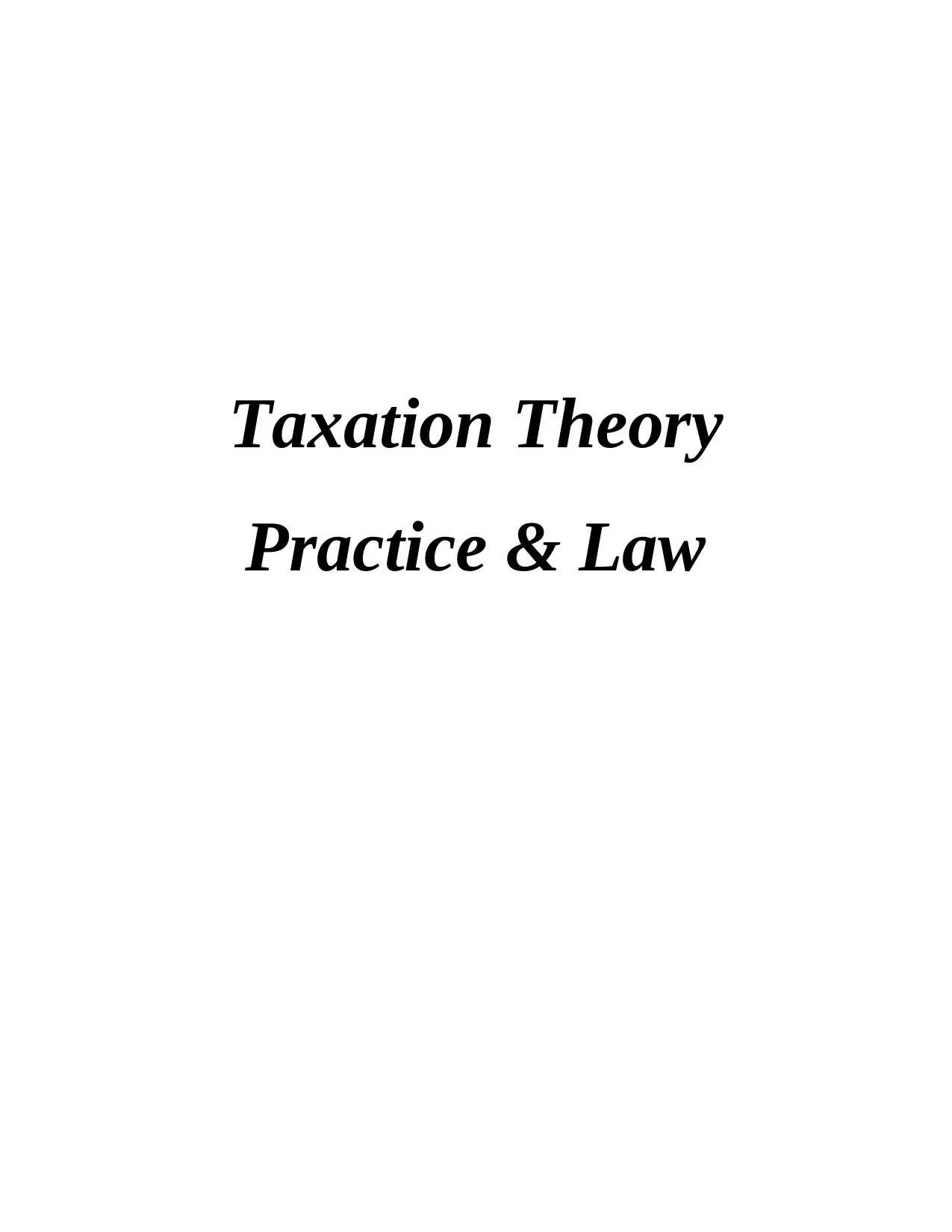
Taxation Theory
Practice & Law
Practice & Law
Paraphrase This Document
Need a fresh take? Get an instant paraphrase of this document with our AI Paraphraser
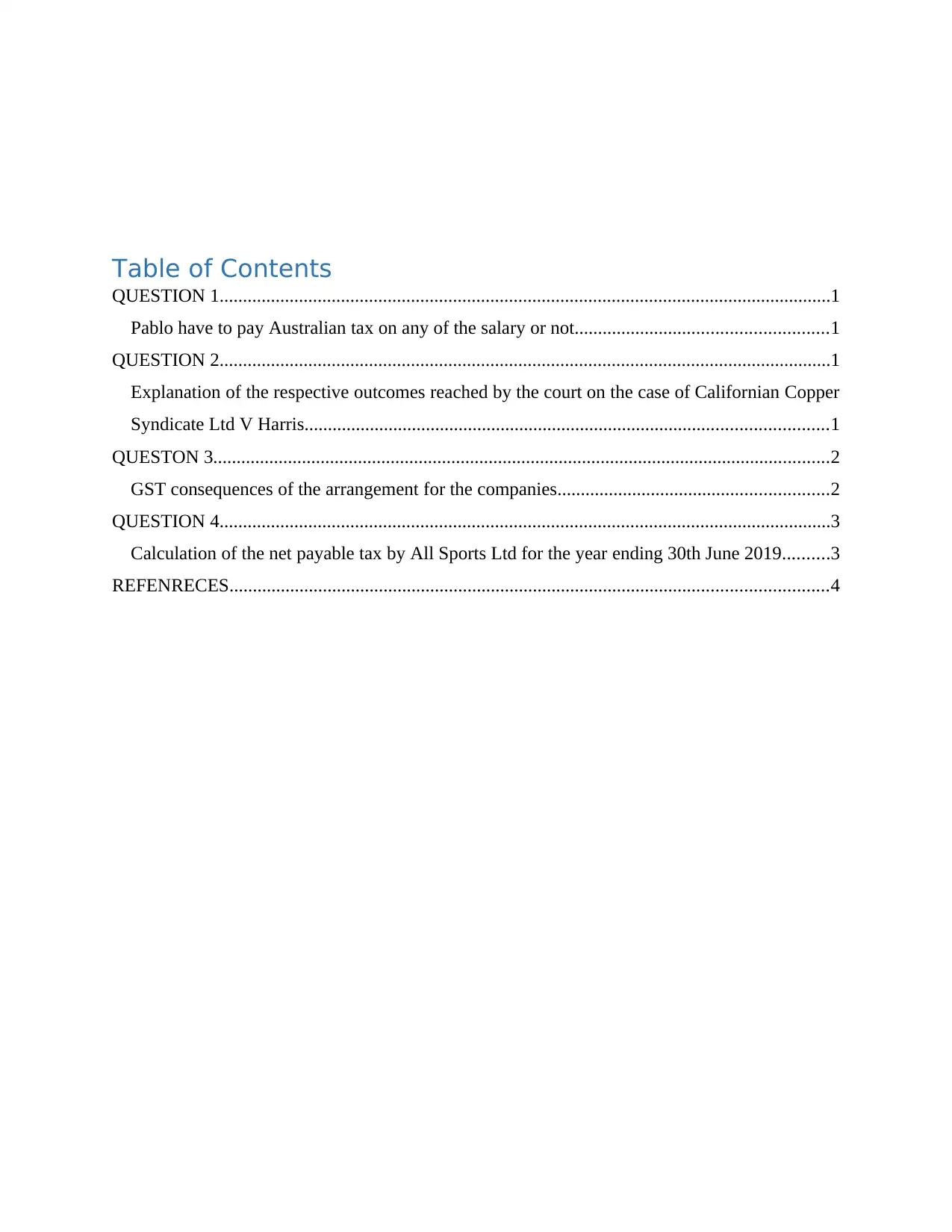
Table of Contents
QUESTION 1...................................................................................................................................1
Pablo have to pay Australian tax on any of the salary or not......................................................1
QUESTION 2...................................................................................................................................1
Explanation of the respective outcomes reached by the court on the case of Californian Copper
Syndicate Ltd V Harris................................................................................................................1
QUESTON 3....................................................................................................................................2
GST consequences of the arrangement for the companies..........................................................2
QUESTION 4...................................................................................................................................3
Calculation of the net payable tax by All Sports Ltd for the year ending 30th June 2019..........3
REFENRECES................................................................................................................................4
QUESTION 1...................................................................................................................................1
Pablo have to pay Australian tax on any of the salary or not......................................................1
QUESTION 2...................................................................................................................................1
Explanation of the respective outcomes reached by the court on the case of Californian Copper
Syndicate Ltd V Harris................................................................................................................1
QUESTON 3....................................................................................................................................2
GST consequences of the arrangement for the companies..........................................................2
QUESTION 4...................................................................................................................................3
Calculation of the net payable tax by All Sports Ltd for the year ending 30th June 2019..........3
REFENRECES................................................................................................................................4
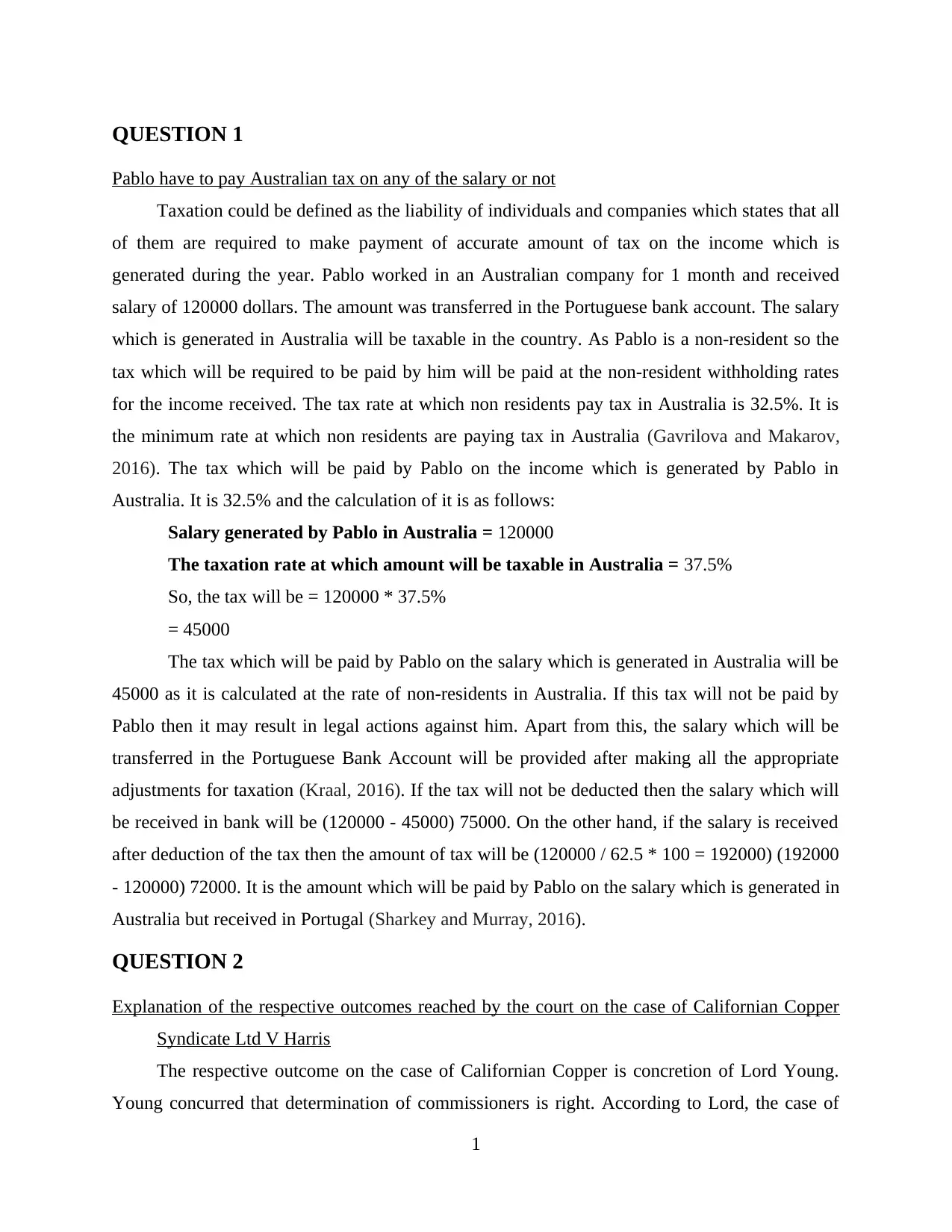
QUESTION 1
Pablo have to pay Australian tax on any of the salary or not
Taxation could be defined as the liability of individuals and companies which states that all
of them are required to make payment of accurate amount of tax on the income which is
generated during the year. Pablo worked in an Australian company for 1 month and received
salary of 120000 dollars. The amount was transferred in the Portuguese bank account. The salary
which is generated in Australia will be taxable in the country. As Pablo is a non-resident so the
tax which will be required to be paid by him will be paid at the non-resident withholding rates
for the income received. The tax rate at which non residents pay tax in Australia is 32.5%. It is
the minimum rate at which non residents are paying tax in Australia (Gavrilova and Makarov,
2016). The tax which will be paid by Pablo on the income which is generated by Pablo in
Australia. It is 32.5% and the calculation of it is as follows:
Salary generated by Pablo in Australia = 120000
The taxation rate at which amount will be taxable in Australia = 37.5%
So, the tax will be = 120000 * 37.5%
= 45000
The tax which will be paid by Pablo on the salary which is generated in Australia will be
45000 as it is calculated at the rate of non-residents in Australia. If this tax will not be paid by
Pablo then it may result in legal actions against him. Apart from this, the salary which will be
transferred in the Portuguese Bank Account will be provided after making all the appropriate
adjustments for taxation (Kraal, 2016). If the tax will not be deducted then the salary which will
be received in bank will be (120000 - 45000) 75000. On the other hand, if the salary is received
after deduction of the tax then the amount of tax will be (120000 / 62.5 * 100 = 192000) (192000
- 120000) 72000. It is the amount which will be paid by Pablo on the salary which is generated in
Australia but received in Portugal (Sharkey and Murray, 2016).
QUESTION 2
Explanation of the respective outcomes reached by the court on the case of Californian Copper
Syndicate Ltd V Harris
The respective outcome on the case of Californian Copper is concretion of Lord Young.
Young concurred that determination of commissioners is right. According to Lord, the case of
1
Pablo have to pay Australian tax on any of the salary or not
Taxation could be defined as the liability of individuals and companies which states that all
of them are required to make payment of accurate amount of tax on the income which is
generated during the year. Pablo worked in an Australian company for 1 month and received
salary of 120000 dollars. The amount was transferred in the Portuguese bank account. The salary
which is generated in Australia will be taxable in the country. As Pablo is a non-resident so the
tax which will be required to be paid by him will be paid at the non-resident withholding rates
for the income received. The tax rate at which non residents pay tax in Australia is 32.5%. It is
the minimum rate at which non residents are paying tax in Australia (Gavrilova and Makarov,
2016). The tax which will be paid by Pablo on the income which is generated by Pablo in
Australia. It is 32.5% and the calculation of it is as follows:
Salary generated by Pablo in Australia = 120000
The taxation rate at which amount will be taxable in Australia = 37.5%
So, the tax will be = 120000 * 37.5%
= 45000
The tax which will be paid by Pablo on the salary which is generated in Australia will be
45000 as it is calculated at the rate of non-residents in Australia. If this tax will not be paid by
Pablo then it may result in legal actions against him. Apart from this, the salary which will be
transferred in the Portuguese Bank Account will be provided after making all the appropriate
adjustments for taxation (Kraal, 2016). If the tax will not be deducted then the salary which will
be received in bank will be (120000 - 45000) 75000. On the other hand, if the salary is received
after deduction of the tax then the amount of tax will be (120000 / 62.5 * 100 = 192000) (192000
- 120000) 72000. It is the amount which will be paid by Pablo on the salary which is generated in
Australia but received in Portugal (Sharkey and Murray, 2016).
QUESTION 2
Explanation of the respective outcomes reached by the court on the case of Californian Copper
Syndicate Ltd V Harris
The respective outcome on the case of Californian Copper is concretion of Lord Young.
Young concurred that determination of commissioners is right. According to Lord, the case of
1
You're viewing a preview
Unlock full access by subscribing today!
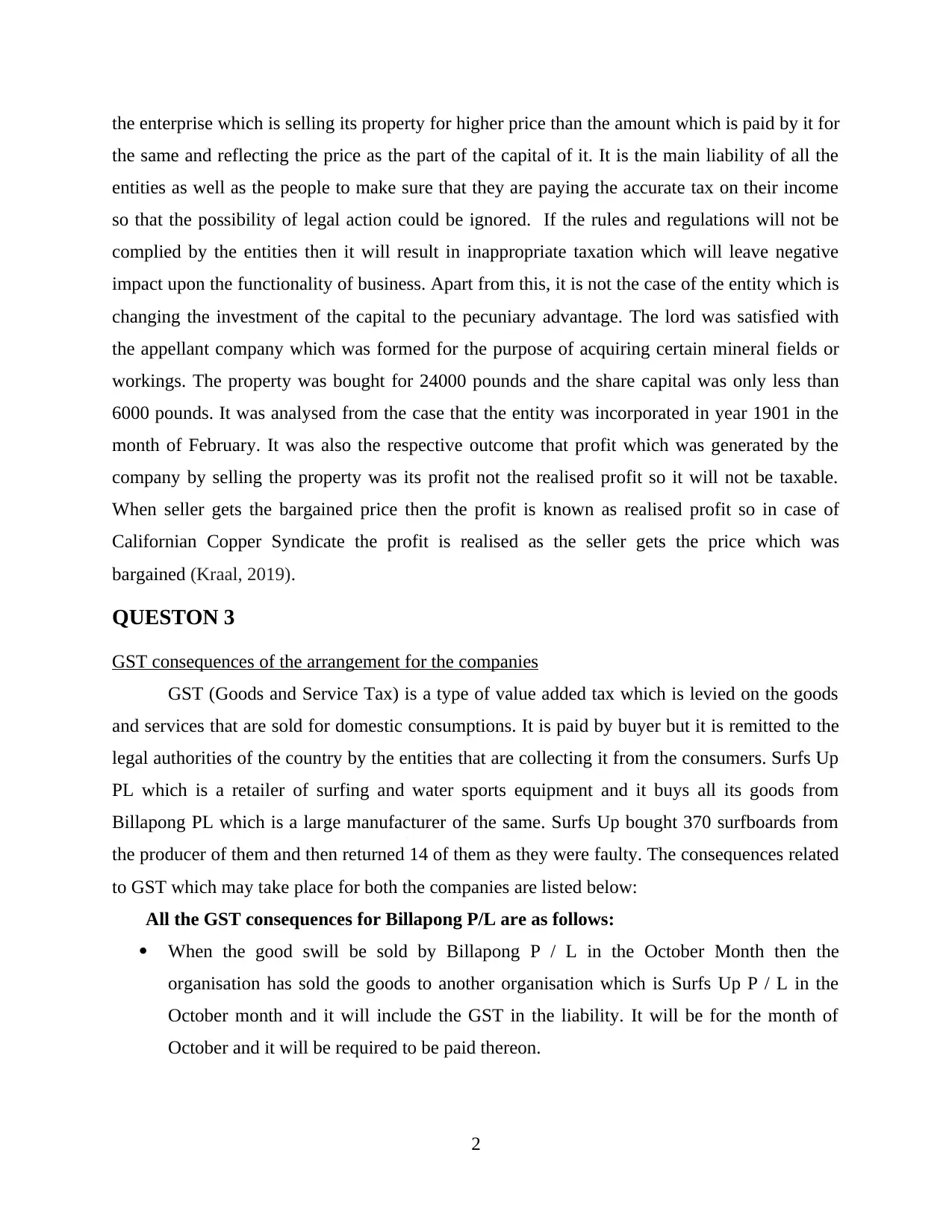
the enterprise which is selling its property for higher price than the amount which is paid by it for
the same and reflecting the price as the part of the capital of it. It is the main liability of all the
entities as well as the people to make sure that they are paying the accurate tax on their income
so that the possibility of legal action could be ignored. If the rules and regulations will not be
complied by the entities then it will result in inappropriate taxation which will leave negative
impact upon the functionality of business. Apart from this, it is not the case of the entity which is
changing the investment of the capital to the pecuniary advantage. The lord was satisfied with
the appellant company which was formed for the purpose of acquiring certain mineral fields or
workings. The property was bought for 24000 pounds and the share capital was only less than
6000 pounds. It was analysed from the case that the entity was incorporated in year 1901 in the
month of February. It was also the respective outcome that profit which was generated by the
company by selling the property was its profit not the realised profit so it will not be taxable.
When seller gets the bargained price then the profit is known as realised profit so in case of
Californian Copper Syndicate the profit is realised as the seller gets the price which was
bargained (Kraal, 2019).
QUESTON 3
GST consequences of the arrangement for the companies
GST (Goods and Service Tax) is a type of value added tax which is levied on the goods
and services that are sold for domestic consumptions. It is paid by buyer but it is remitted to the
legal authorities of the country by the entities that are collecting it from the consumers. Surfs Up
PL which is a retailer of surfing and water sports equipment and it buys all its goods from
Billapong PL which is a large manufacturer of the same. Surfs Up bought 370 surfboards from
the producer of them and then returned 14 of them as they were faulty. The consequences related
to GST which may take place for both the companies are listed below:
All the GST consequences for Billapong P/L are as follows:
When the good swill be sold by Billapong P / L in the October Month then the
organisation has sold the goods to another organisation which is Surfs Up P / L in the
October month and it will include the GST in the liability. It will be for the month of
October and it will be required to be paid thereon.
2
the same and reflecting the price as the part of the capital of it. It is the main liability of all the
entities as well as the people to make sure that they are paying the accurate tax on their income
so that the possibility of legal action could be ignored. If the rules and regulations will not be
complied by the entities then it will result in inappropriate taxation which will leave negative
impact upon the functionality of business. Apart from this, it is not the case of the entity which is
changing the investment of the capital to the pecuniary advantage. The lord was satisfied with
the appellant company which was formed for the purpose of acquiring certain mineral fields or
workings. The property was bought for 24000 pounds and the share capital was only less than
6000 pounds. It was analysed from the case that the entity was incorporated in year 1901 in the
month of February. It was also the respective outcome that profit which was generated by the
company by selling the property was its profit not the realised profit so it will not be taxable.
When seller gets the bargained price then the profit is known as realised profit so in case of
Californian Copper Syndicate the profit is realised as the seller gets the price which was
bargained (Kraal, 2019).
QUESTON 3
GST consequences of the arrangement for the companies
GST (Goods and Service Tax) is a type of value added tax which is levied on the goods
and services that are sold for domestic consumptions. It is paid by buyer but it is remitted to the
legal authorities of the country by the entities that are collecting it from the consumers. Surfs Up
PL which is a retailer of surfing and water sports equipment and it buys all its goods from
Billapong PL which is a large manufacturer of the same. Surfs Up bought 370 surfboards from
the producer of them and then returned 14 of them as they were faulty. The consequences related
to GST which may take place for both the companies are listed below:
All the GST consequences for Billapong P/L are as follows:
When the good swill be sold by Billapong P / L in the October Month then the
organisation has sold the goods to another organisation which is Surfs Up P / L in the
October month and it will include the GST in the liability. It will be for the month of
October and it will be required to be paid thereon.
2
Paraphrase This Document
Need a fresh take? Get an instant paraphrase of this document with our AI Paraphraser
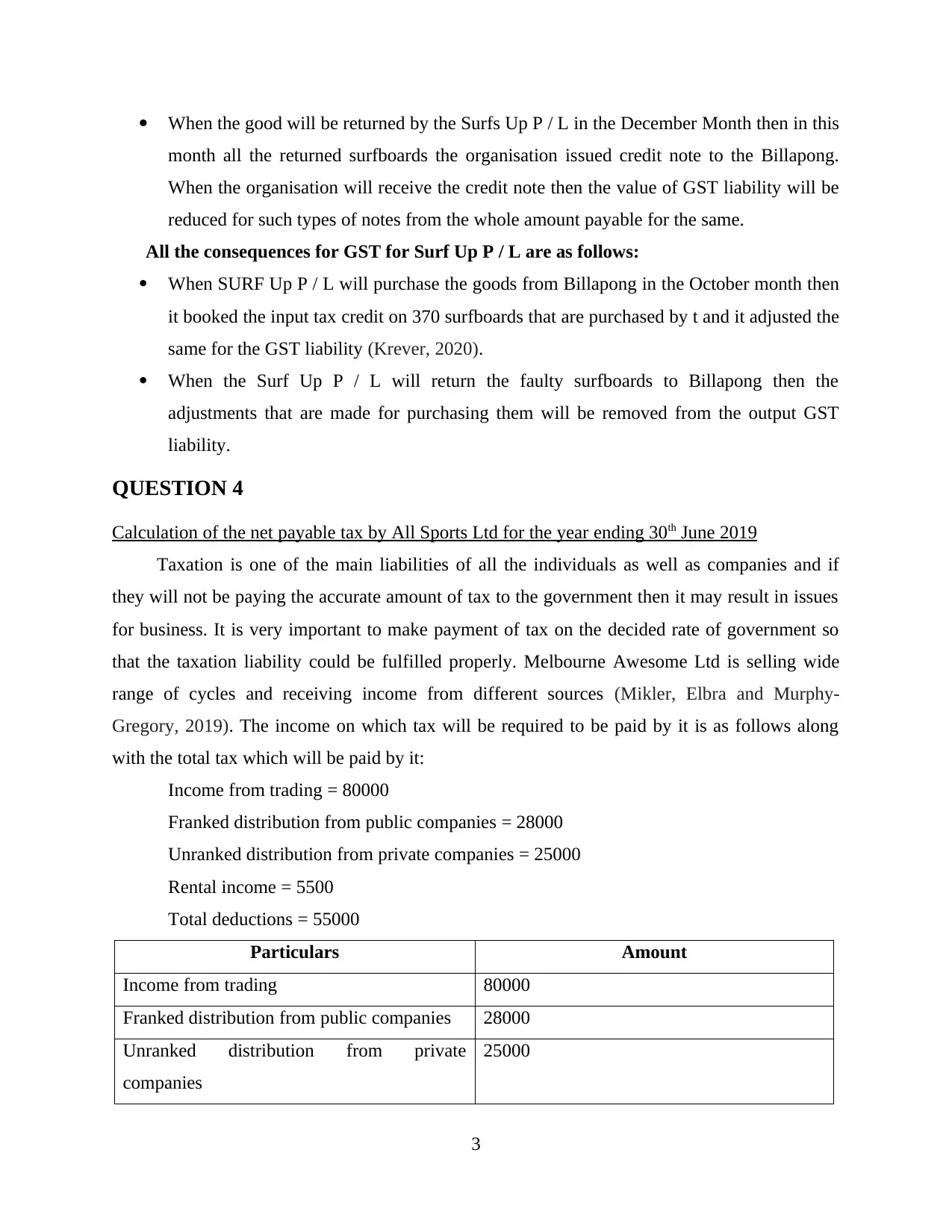
When the good will be returned by the Surfs Up P / L in the December Month then in this
month all the returned surfboards the organisation issued credit note to the Billapong.
When the organisation will receive the credit note then the value of GST liability will be
reduced for such types of notes from the whole amount payable for the same.
All the consequences for GST for Surf Up P / L are as follows:
When SURF Up P / L will purchase the goods from Billapong in the October month then
it booked the input tax credit on 370 surfboards that are purchased by t and it adjusted the
same for the GST liability (Krever, 2020).
When the Surf Up P / L will return the faulty surfboards to Billapong then the
adjustments that are made for purchasing them will be removed from the output GST
liability.
QUESTION 4
Calculation of the net payable tax by All Sports Ltd for the year ending 30th June 2019
Taxation is one of the main liabilities of all the individuals as well as companies and if
they will not be paying the accurate amount of tax to the government then it may result in issues
for business. It is very important to make payment of tax on the decided rate of government so
that the taxation liability could be fulfilled properly. Melbourne Awesome Ltd is selling wide
range of cycles and receiving income from different sources (Mikler, Elbra and Murphy-
Gregory, 2019). The income on which tax will be required to be paid by it is as follows along
with the total tax which will be paid by it:
Income from trading = 80000
Franked distribution from public companies = 28000
Unranked distribution from private companies = 25000
Rental income = 5500
Total deductions = 55000
Particulars Amount
Income from trading 80000
Franked distribution from public companies 28000
Unranked distribution from private
companies
25000
3
month all the returned surfboards the organisation issued credit note to the Billapong.
When the organisation will receive the credit note then the value of GST liability will be
reduced for such types of notes from the whole amount payable for the same.
All the consequences for GST for Surf Up P / L are as follows:
When SURF Up P / L will purchase the goods from Billapong in the October month then
it booked the input tax credit on 370 surfboards that are purchased by t and it adjusted the
same for the GST liability (Krever, 2020).
When the Surf Up P / L will return the faulty surfboards to Billapong then the
adjustments that are made for purchasing them will be removed from the output GST
liability.
QUESTION 4
Calculation of the net payable tax by All Sports Ltd for the year ending 30th June 2019
Taxation is one of the main liabilities of all the individuals as well as companies and if
they will not be paying the accurate amount of tax to the government then it may result in issues
for business. It is very important to make payment of tax on the decided rate of government so
that the taxation liability could be fulfilled properly. Melbourne Awesome Ltd is selling wide
range of cycles and receiving income from different sources (Mikler, Elbra and Murphy-
Gregory, 2019). The income on which tax will be required to be paid by it is as follows along
with the total tax which will be paid by it:
Income from trading = 80000
Franked distribution from public companies = 28000
Unranked distribution from private companies = 25000
Rental income = 5500
Total deductions = 55000
Particulars Amount
Income from trading 80000
Franked distribution from public companies 28000
Unranked distribution from private
companies
25000
3
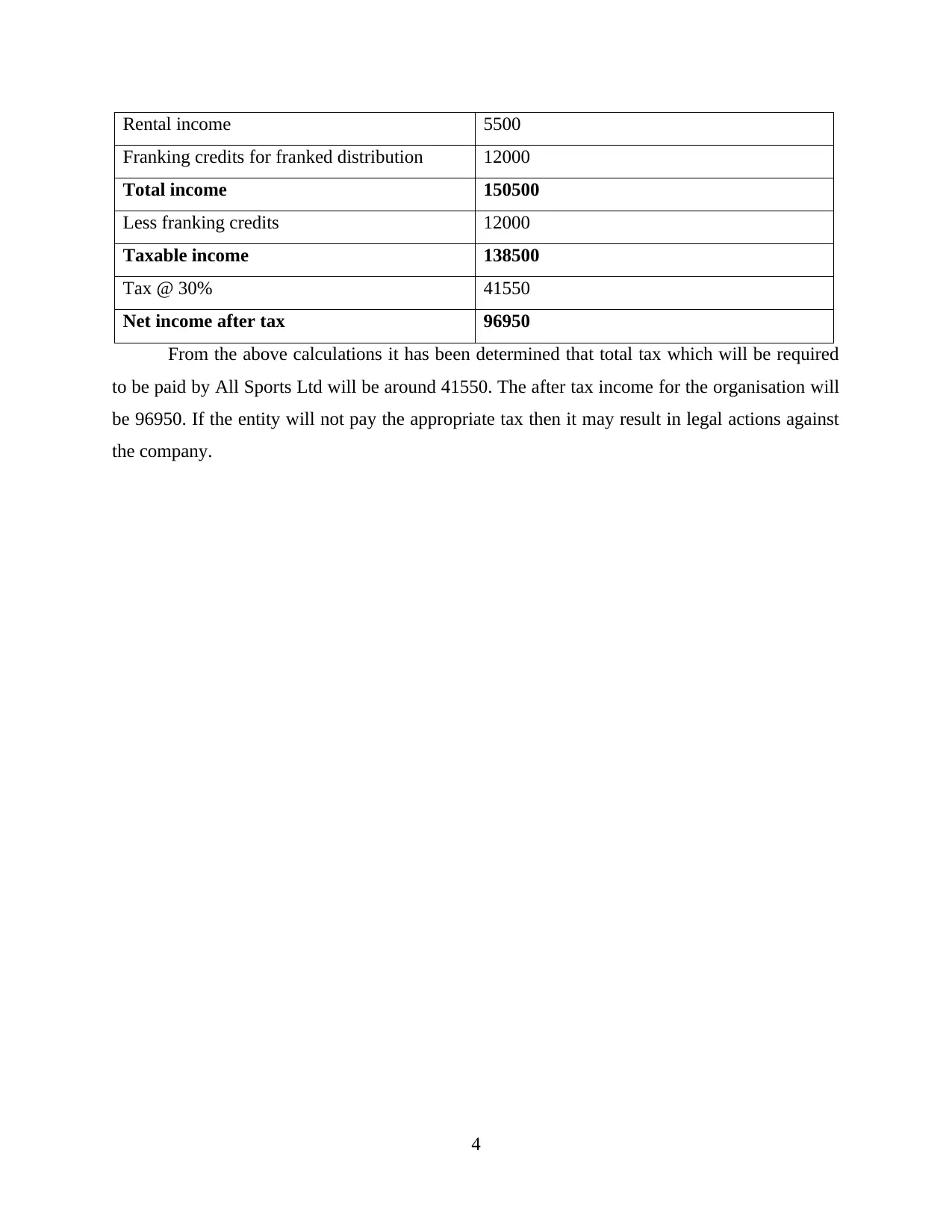
Rental income 5500
Franking credits for franked distribution 12000
Total income 150500
Less franking credits 12000
Taxable income 138500
Tax @ 30% 41550
Net income after tax 96950
From the above calculations it has been determined that total tax which will be required
to be paid by All Sports Ltd will be around 41550. The after tax income for the organisation will
be 96950. If the entity will not pay the appropriate tax then it may result in legal actions against
the company.
4
Franking credits for franked distribution 12000
Total income 150500
Less franking credits 12000
Taxable income 138500
Tax @ 30% 41550
Net income after tax 96950
From the above calculations it has been determined that total tax which will be required
to be paid by All Sports Ltd will be around 41550. The after tax income for the organisation will
be 96950. If the entity will not pay the appropriate tax then it may result in legal actions against
the company.
4
You're viewing a preview
Unlock full access by subscribing today!
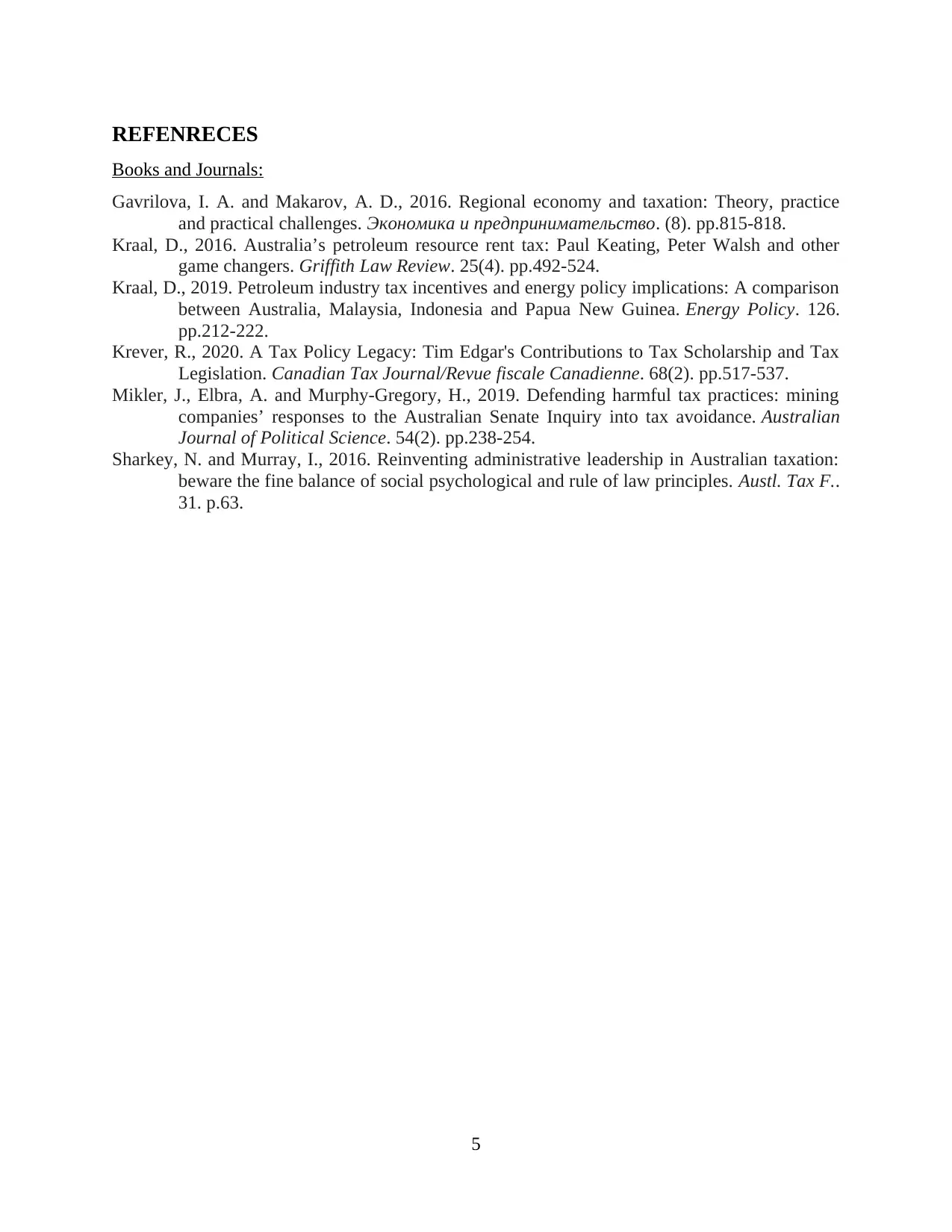
REFENRECES
Books and Journals:
Gavrilova, I. A. and Makarov, A. D., 2016. Regional economy and taxation: Theory, practice
and practical challenges. Экономика и предпринимательство. (8). pp.815-818.
Kraal, D., 2016. Australia’s petroleum resource rent tax: Paul Keating, Peter Walsh and other
game changers. Griffith Law Review. 25(4). pp.492-524.
Kraal, D., 2019. Petroleum industry tax incentives and energy policy implications: A comparison
between Australia, Malaysia, Indonesia and Papua New Guinea. Energy Policy. 126.
pp.212-222.
Krever, R., 2020. A Tax Policy Legacy: Tim Edgar's Contributions to Tax Scholarship and Tax
Legislation. Canadian Tax Journal/Revue fiscale Canadienne. 68(2). pp.517-537.
Mikler, J., Elbra, A. and Murphy-Gregory, H., 2019. Defending harmful tax practices: mining
companies’ responses to the Australian Senate Inquiry into tax avoidance. Australian
Journal of Political Science. 54(2). pp.238-254.
Sharkey, N. and Murray, I., 2016. Reinventing administrative leadership in Australian taxation:
beware the fine balance of social psychological and rule of law principles. Austl. Tax F..
31. p.63.
5
Books and Journals:
Gavrilova, I. A. and Makarov, A. D., 2016. Regional economy and taxation: Theory, practice
and practical challenges. Экономика и предпринимательство. (8). pp.815-818.
Kraal, D., 2016. Australia’s petroleum resource rent tax: Paul Keating, Peter Walsh and other
game changers. Griffith Law Review. 25(4). pp.492-524.
Kraal, D., 2019. Petroleum industry tax incentives and energy policy implications: A comparison
between Australia, Malaysia, Indonesia and Papua New Guinea. Energy Policy. 126.
pp.212-222.
Krever, R., 2020. A Tax Policy Legacy: Tim Edgar's Contributions to Tax Scholarship and Tax
Legislation. Canadian Tax Journal/Revue fiscale Canadienne. 68(2). pp.517-537.
Mikler, J., Elbra, A. and Murphy-Gregory, H., 2019. Defending harmful tax practices: mining
companies’ responses to the Australian Senate Inquiry into tax avoidance. Australian
Journal of Political Science. 54(2). pp.238-254.
Sharkey, N. and Murray, I., 2016. Reinventing administrative leadership in Australian taxation:
beware the fine balance of social psychological and rule of law principles. Austl. Tax F..
31. p.63.
5
1 out of 7
Related Documents
Your All-in-One AI-Powered Toolkit for Academic Success.
+13062052269
info@desklib.com
Available 24*7 on WhatsApp / Email
![[object Object]](/_next/static/media/star-bottom.7253800d.svg)
Unlock your academic potential
© 2024 | Zucol Services PVT LTD | All rights reserved.





